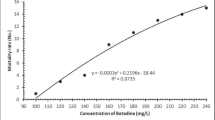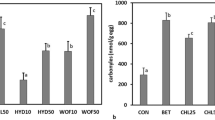Summary
Experiments were carried out to evaluate several properties determining the mutual influence of the system: fish-bath-malachite green-pathogen.
The toxicity of malachite green solutions in concentrations varying between 1 : 80,000 and 1 : 2,560,000 was tested on immature sand whiting. As regards the toxicity of 1 : 80,000 solutions, for practical purposes no distinction between fish of different size, between equal concentrations of chloride and oxalate salts of the dye, or between fresh and decolourized solutions appears necessary.
The survival time increased appreciably with decreasing temperature for the range 13.5–28.0°C.
The dye solutions always showed significant decolourization when the pH was higher than 5.
Several body tissues of the fish, notably the central nervous system and the lateral red muscles, were stained by fresh as well as decolourized malachite green solutions.
The dye proved bacteriostatic but not bactericidal, to pseudomonad and coccus cultures when 1 : 80,000 solutions were used. Once decolourized, the dye became a less effective bacteriostatic.
The addition of the dye, or formaldehyde, to the bath induced hyperventilation in the fish.
A triple dye mixture, consisting of malachite green, brilliant green and crystal violet, was found to be a valuable therapeutic agent.
Zusammenfassung
Einige Versuche werden durchgeführt zur Erklärung verschiedener Eigenschaften, die die gegenseitige Einwirkung in dem System: Fisch - Bad - Malachitgrün - Pathogen bestimmen.
Die Toxizität von Malachitgrün-Lösungen in Konzentrationen welche variierten zwischen 1 : 80,000 and 1 : 2,560,000 wurde geprüft an jungen ‘Sand Whiting’. Was die Toxizität der 1 : 80,000 Lösungen betrifft, scheint, für praktischen Zwecke, kein Unterschied zu sein zwischen Fischen verschiedener Länge, zwischen gleichen Konzentrationen von Chlorid und Oxalat-Salzen des Farbstoffes, oder zwischen frischen und entfärbten Lösungen. Die Überlebungszeit nahm merklich zu, wenn die Temperatur erniedrigt war, im Gebiet von 13.5°–28.0°C. Die Farbstoff-Lösungen zeigten erhebliche Entfärbung, wenn der pH - Wert grösser war als 5. Verschiedene Körpergewebe des Fisches, insbesondere das Zentralnervensystem und die lateralen roten Muskeln, werden von frischen sowie entfärbten Lösungen grün gefärbt. Der Farbstoff zeigte in 1 : 80,000 Lösungen bakteriostatische, aber keine bakterizide Wirkung, wenn geprüft an Pseudomonas und Kokkus Kulturen. Zusatz des Farbstoffes, oder Formaldehyde, zum Bade veranlasste in dem Fisch Hyperventilation. Ein Tripelfarbstoff-Gemisch, das bestand aus Malachitgrün, Brilliantgrün und Kristallviolett, zeigte sich ein wertvolles Therapeutikum.
Similar content being viewed by others
References
Amlacher, E. - 1961 - Die Wirkung des Malachitgrüns auf Fische, Fischparasiten (Ichthyophtirius, Trichodina), Kleinkrebse und Wasserpflanzen.Dtsch. Fisch. Z. 8: 12–15.
Anthony-Barbier, A. M. &Rumpf, P. - 1959 - Etude spectrophotométrique des divers équilibres d'ionisation d'un dérivé diaminé du triphenylcarbinol.Bull. Soc. Chim. France 225: 1474–1481.
Downing, K. M. - 1954 - The influence of dissolved oxygen concentration on the toxicity of potassium cyanide to rainbow trout.J. exp. Biol. 31: 161–164.
Freeman, J. A. - 1950 - Oxygen consumption, brain metabolism and respiratory movements of goldfish during temperature acclimatization with special reference to lowered temperature.Biol. Bull. 99: 416–424.
Gale, E. F. &Mitchell, P. D. - 1947 - The assimilation of amino acids by bacteria. 4. The action of triphenylmethane dyes on glutamic acid-assimilation.J. gen. Microbiol. 1: 299–312.
Goldacre, R. J. &Phillips, J. N. - 1949 - The ionization of basic triphenylmethane dyes.J. chem. Soc. part 3: 1724–1732.
Hoshina, T. &Chiba, T. - 1957 - On the bacteriostatic power of malachite green against the causative bacteria of vibriodisease of rainbow trout.Jap. Soc. Sci. Fish Bull. 23: 199–201.
Katz, M. &Chadwick, G. G. - 1961 - Toxicity of endrin to some Pacific Northwest fishes.Trans. Amer. Fish. Soc. 90: 394–397.
Litsky, M.,Mallman, W. L. &Fifield, C. W. - 1952 - Ethyl violet. A selective dye for the isolation of Gram-negative bacteria.Stain Technol. 27: 229–232.
Lloyd, R. - 1961 - Effect of dissolved oxygen concentrations on the toxicity of several poisons to rainbow trout (Salmo gairdnerii).J. exp. Biol. 38: 447–456.
McFarland, W. N. - 1959 - A study of the effects of anaesthetics on the behaviour and physiology of fishes.Publ. Inst. Mar. Sci. Univ. Texas 6: 23–55.
Saunders, R. L. - 1962 - The irrigation of the gills in fishes. 2. Efficiency of oxygen uptake in relation to respiratory flow activity and concentration of oxygen and carbon dioxide.Canad. J. Zool. 40: 817–862.
Author information
Authors and Affiliations
Rights and permissions
About this article
Cite this article
Lanzing, W.J.R. Observations on malachite green in relation to its application to fish diseases. Hydrobiologia 25, 426–441 (1965). https://doi.org/10.1007/BF00838505
Received:
Published:
Issue Date:
DOI: https://doi.org/10.1007/BF00838505




